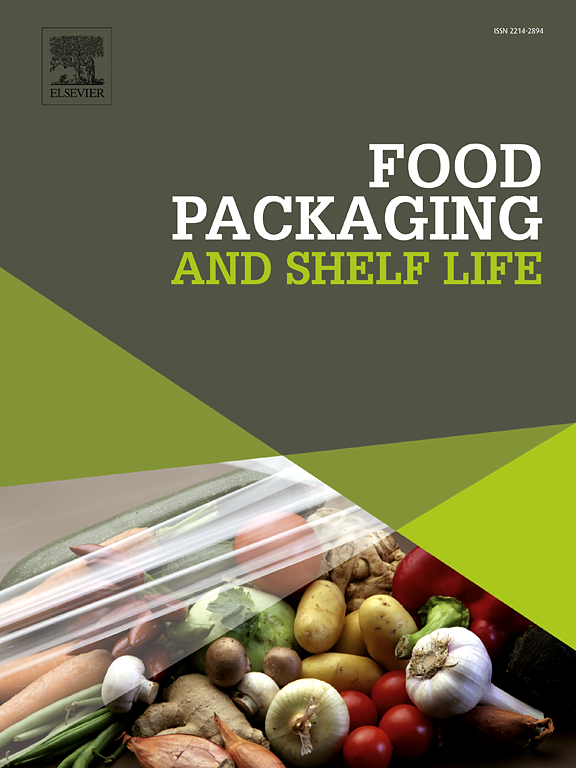用于抗菌包装的乙烯乙基醇/过氧化钙复合薄膜
IF 10.6
1区 农林科学
Q1 FOOD SCIENCE & TECHNOLOGY
引用次数: 0
摘要
抗菌包装可以防止微生物的生长,从而延长食品的保质期。过氧化钙(CaO2)与H2O接触时会释放H2O2,因此有望成为液态H2O2的替代品。尽管氧化钙具有很强的抗菌性能,但其在抗菌包装中的应用研究有限。本研究采用溶液浇铸法制备了CaO2含量为0.5 ~ 5 wt%的乙烯醇与过氧化钙(EVOH/CaO2)复合薄膜。此外,还广泛分析了它们的力学、化学、热、形态和势垒性能。含有3和5 wt% CaO2的EVOH/CaO2复合膜对革兰氏阴性菌和革兰氏阳性菌的微生物生长均有显著的抑制作用,这主要归因于膜中H2O2的释放。此外,细胞毒性研究证实EVOH/CaO2复合膜无细胞毒性,可安全使用。然而,由于EVOH与CaO2纳米粒子之间的相互作用较弱,并且CaO2在EVOH基体中的分散较差,EVOH/CaO2复合膜未能改善其屏障性能和热稳定性。这些发现突出了CaO2和EVOH/CaO2复合膜作为高效抗菌材料的潜力。进一步指出,为了提高薄膜在食品包装和生物医药领域的适用性,还需要加强过氧化氢与EVOH之间的化学相互作用。本文章由计算机程序翻译,如有差异,请以英文原文为准。
Ethylene vinyl alcohol/calcium peroxide composite films for antibacterial packaging applications
Antibacterial packaging prevents the growth of microorganisms, thus extending the shelf life of food products. Calcium peroxide (CaO2) releases H2O2 when in contact with H2O and therefore exhibits promise as an alternative to liquid H2O2. Despite its strong antibacterial properties, studies regarding the use of CaO2 in antibacterial packaging are limited. In this study, ethylene vinyl alcohol and calcium peroxide (EVOH/CaO2) composite films with varied CaO2 contents of 0.5–5 wt% were prepared via solution casting. Further, their mechanical, chemical, thermal, morphological, and barrier properties were extensively analyzed. The EVOH/CaO2 composite films containing 3 and 5 wt% CaO2 significantly inhibited the microbial growth of both Gram-negative and Gram-positive bacteria, which was attributed to the release of H2O2 from the films. Furthermore, cytotoxicity studies confirmed that the EVOH/CaO2 composite films were noncytotoxic and safe for use. However, the EVOH/CaO2 composite films failed to improve the barrier properties and thermal stability because of the weak interaction between EVOH and the CaO2 nanoparticles and poor dispersion of CaO2 into the EVOH matrix. These findings highlight the potential of the CaO2 and EVOH/CaO2 composite films as efficient antibacterial materials. Furthermore, they indicate the need to strengthen the chemical interaction between CaO2 and EVOH so as to enhance the applicability of the films in food packaging and biomedicine.
求助全文
通过发布文献求助,成功后即可免费获取论文全文。
去求助
来源期刊

Food Packaging and Shelf Life
Agricultural and Biological Sciences-Food Science
CiteScore
14.00
自引率
8.80%
发文量
214
审稿时长
70 days
期刊介绍:
Food packaging is crucial for preserving food integrity throughout the distribution chain. It safeguards against contamination by physical, chemical, and biological agents, ensuring the safety and quality of processed foods. The evolution of novel food packaging, including modified atmosphere and active packaging, has extended shelf life, enhancing convenience for consumers. Shelf life, the duration a perishable item remains suitable for sale, use, or consumption, is intricately linked with food packaging, emphasizing its role in maintaining product quality and safety.
 求助内容:
求助内容: 应助结果提醒方式:
应助结果提醒方式:


